If you reach Sanchi without knowing what our jataka tales are and without having at least one Rs 200 currency note in your wallet, you’re going to miss out on the two big experiences you can have there. Not knowing the jataka tales will mean you will remain amazed by all the well-preserved stone carvings but will miss out on the connected stories… and without that Rs 200 currency note, you’ll never get the opportunity to boast on the social media that you know about Sanchi Stupa being featured on the reverse. If you study the angles correctly, you may even manage to click a picture that is similar to the one on the note.
Sanchi and the Stupa there, however, are much larger than a few tales and a selfie. Let me add here that if you ask people who have been to Bhopal, you’ll surprised at their surprise when you tell them that Sanchi and its UNESCO world heritage site (declared in 1989) are less than 50 kms and absolutely worth a day trip with a picture opportunity at the spot where the Tropic of Cancer crosses the highway as a bonus! An over-night stay at Sanchi in Raisen district of Madhya Pradesh will also mean that you’ll be able to watch the sound and light show at the Stupa and, if you are adventurous enough, plan a trip to Udaigiri caves as well. But for now, let us focus on the Stupa at Sanchi where Buddha never came in his lifetime… yes, only his relics rest within the domed structure.



The hop at Sanchi spans hundreds of years
The four ornamental gateways or Toranas with all the charming stories in stone came up around 200 years after the simple hemispherical brick structure was commissioned by Emperor Ashoka in the 3rd century BC. This structure has a chhatri on top that gives the monument a symbolic high rank as Buddha’s relics are sheltered here. Why Sanchi? Well, Sanchi also happens to be the hometown of Devi, Emperor Ashoka’s wife. This rather sums up that decision, doesn’t it?
We were fortunate to be in the company of Dr K K Muhhamed, the world-renowned archeologist, who told us that during the Mauryan period the initial construction of the Stupa was with bricks and then, with a twinkle in his eyes, he added, ‘The top of the dome isn’t a perfect sphere. It looks more like an inverted bowl that Buddha carried.’ The significance of this may be symbolic but the interpretations can go beyond mere tales and enter the world of metaphysics.

Multiple centuries and the rules of the Mauryans, Satvanas, and the Shagunas ensured that the Stupa went way beyond being just a house for Buddha’s relics to being one with fanciful architectural adornments. I could see the top of a wonderfully carved and polished sandstone half a pillar under a canopy there… the bottom half still standing and possibly wondering if any of the travel enthusiasts milling around with smartphones in their hands could even read the inscription in Sankha lipi from the Gupta period! These additions went on until the 12the century AD despite a fair degree of violent desecration attempts even in the intervening period… for instance, Pushyamitra Sunga vandalized it but history of culture will surely thank his son Agnimitra for rebuilding the Stupa.
However, what we see today is because of hundreds of manhours of painstaking restoration work and the process was majorly done between 1912 and 1919 under the supervision of Sir John Marshall. Travel enthusiasts must spend a few hours browsing through the notes and replicas kept inside the Sanchi Archaeological Museum. And once the evening sets in, one can trudge upwards again to the Stupa for a revision of cultural history at the Stupa sound and light show.
The gateways are eager to tell stories
Stories related to Buddha must have tended to become significant in both number and their public demand because the later additions include the highly ornamental gateways that not only narrate his story but the stories that he was fond of narrating… and this brings us to the jataka tales.

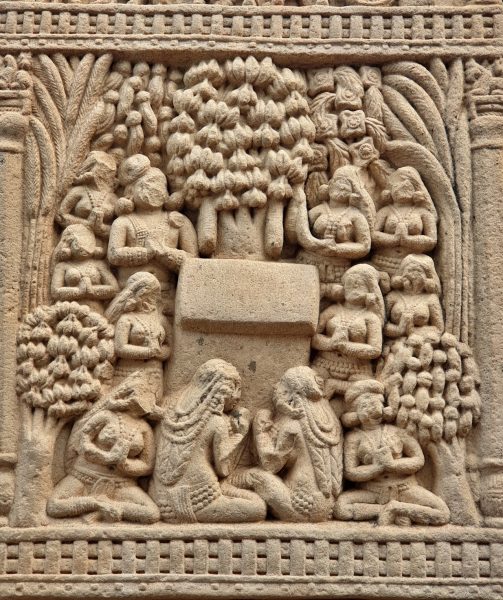
In simple communicable language, the jataka tales are about the former lives of Buddha while he was a Boddhisattva (the stage prior to his attaining enlightenment) and are an important part of Buddhist art and literature. These tales or fables include those where morality and good behaviour are extolled and people of all ages find them interesting. The best part is that the tales are self-explanatory though the presence and narration by an expert or even a guide does help.
One of the panels on the gates is about Bimbisara and his royal cortege from the city of Rajgriha out to visit Buddha because the throne in the panel is empty. Then there are panels that are visual treats of the Buddha’s many miracles… one of them being of Buddha ssemingly walking on the river Nairanjana. The river is in spate and the boatmen are hurrying as they assume Buddha needs assistance, but his is there appearing to levitate and walking on water. One of the stories shows that Buddha wasn’t really happy to find non-Buddhist ascetic displaying their spiritual powers by doing things to impress people. Buddha then decides to let the monks know that showing-off of supranormal power to impress isn’t quite the right way… and all these stories are there on the panels.
There is no end to learning in Sanchi
The entire gamut of artworks here is story-telling done with a lot of style. The stupa has stairway balustrade reliefs include flame palmette, flame palmette and lotus, peacock, woman riding a centaur, half lotus, lion, elephant, elephant with branch, and floral motifs besides others.

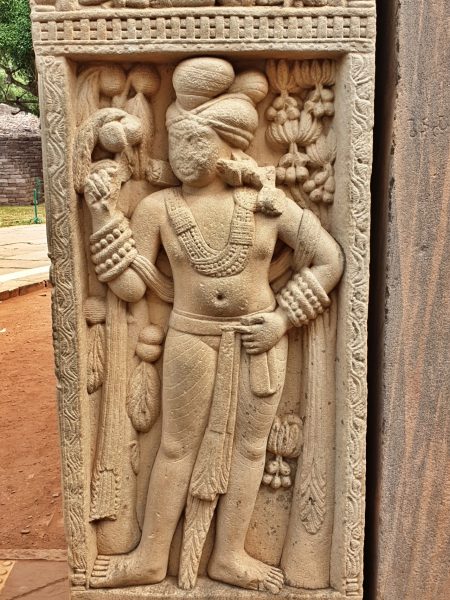
The architecture that one see here at Sanchi includes classical Greek designs and Persian Achaemenid influences besides works done by the local artisans. Sanchi celebrates a convergence of talents and this is what we need to appreciate. However, to get a complete view of things, one does need to visit the Archaeological museum as well where one can see some of the things that aren’t there at the Stupa site. This place compels one to go round the stupa many times, admiring not just the stone carvings but also the fact that there are excavations of a site where monks stayed and prayed, and one can admire the shalabhanjika or the dancing nymph at the corner of a pillar, the apsidal in the backyard outside the stupa, a lotus base of an Ashokan capital, and a few Gupta-era Hindu temples still there in the precincts. Mason marks that tell their own stories and inscriptions, of which some are in a language different from others which indicates that workers were from different places and communicated in different languages. The place is full of mind-boggling cultural and historical tales that needs one to spend time reading about them… or at least pause and wonder at the kind of cultural convergence that and harmonious co-existence that was present in the region even centuries ago.
The tourist perspective
Even in mid-March, the time I was there, the temperature soared and at times the heritage-oriented narrative went unheeded… it was partly because I was interested in also going around and photographing the monument from various angles. The township is developing and does have a few hotels with basic amenities.


In between all this information and visual delights, I had almost missed hearing two rather important stories. The first is during all the phases of the Stupa build-up, it was donations from devotees that helped construct every little sculpture that one sees. This is because royal patronage was absent. These devotees often had the option of requesting for their favourite scene from the life of Buddha carved on the panels and thus we also find their names inscribed at places. Our esteemed guide told us that this is one reason why some scenes and episodes have been repeated.
The other valuable story that must be included in this short article is that the first instinct of the 19th century Europeans was to try and pull out interesting works here. An example is of the French wanting to cart away the nearly completely preserved Eastern gateway to France. However, Shahjehan Begum, the then ruler of Bhopal and her successor Sultan Jehan Begum insisted that only plaster casts be made. In fact, they also contributed to restoration efforts during this time. It isn’t that foreigners were all forces out to pillage because it was General Henry Taylor who first documented the existence of this place in 1818 and, in more ways than one, prevented it from going into desolate degradation.
Sanchi is as much about aesthetic stone carvings as it is about Buddhist art and literature. It is as much about multiple influences in its construction as it is about multiple religions and creeds coming together to restore and preserve it. Sanchi, to my mind, is a great example of the world coming together to let the future have a glimpse into our glorious past.
.
.
This article was first published in Travel Links – Sept/Oct 2020 issue:
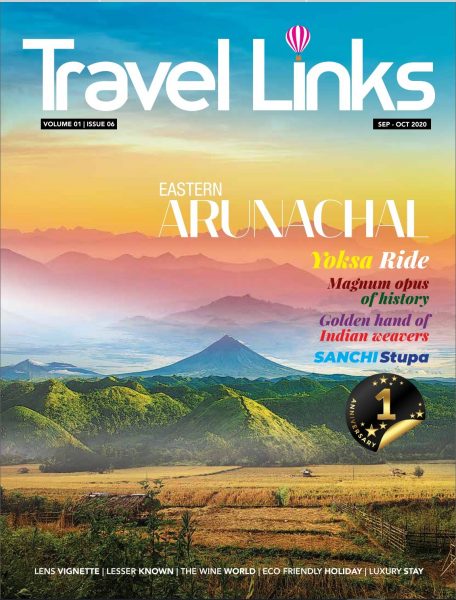
Other pictures that I clicked during this trip:







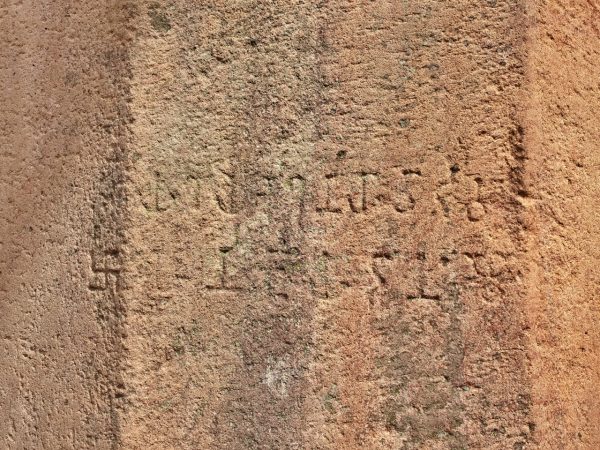
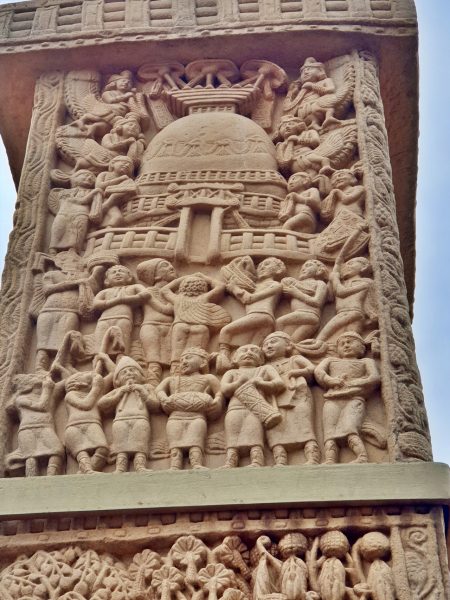









.
.
.
Arvind Passey
23 September 2020









4 comments
Vishal Rajpal says:
Sep 24, 2020
Sorry sie this question is totally unrelated from the context.
But I need to ask this burning question inside me from the first time I started following you and your work is how you come up with these awesome ideas to write about?
Arvind Passey says:
Sep 24, 2020
Vishal, everything in this world is awesome… just look around and tell me if there is anything that does not deserve to be written about. So far as the writing style is concerned, it develops over a period of writing.
Thanks for visiting my blog… do visit again.
Shikha Sinha says:
Sep 24, 2020
Minute details and observation are awesome, and have made this Heritage site all the more must-see destination.
Arvind Passey says:
Sep 24, 2020
Thank you, Shikha… however, as I re-read the article a few minutes back, I could see a few lapses and errors in the sentences. Will correct them tonight. Well, writers cannot be their own editors, you see. 🙂
Do read my post on Orchha and Bhimbetaka as well… and I will soon be uploading articles on Chanderi, Bhopal’s famous Masajid and their Begums, and a few other interesting stories from this trip to a part of MP.